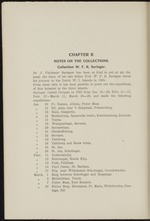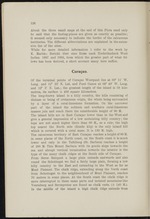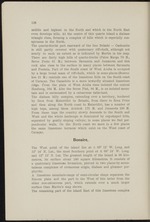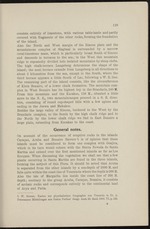| 1 |
 |
“...S.
Collection W. F. R. Suringar.
Dr. J. Valckenier Suringar has been so kind to put at my dis-
posal the diary of his late father Prof. W. F. R. Suringar about
his journey to the Dutch W. I. Islands in 1885.
From these data it has been possible to point out the expeditions
of this botanist in the three islands.
Suringar visited Curasao in 1885 from Jan. 10—28, Febr. 11—17,
Febr. 27- March 11, March 28—29, and made the following
expeditions
Jan. 10 Ft. Nassau, Altena, Pieter Maai.
n 12 Rif, plain near ’t Hospitaal, Priesterberg.
n 13 Hato, Gasparito.
9 14 Beekenburg, Spaansche water, Kabrietenberg, Zuurzak.
i) 17 Veeris.
7i 19 Westpuntbaai, Savonet.
n 20 Savonetbaai.
n 21 Christoffelberg.
7) 22 Savonet.
n 23 Tafelberg.
n 24 Tafelberg and Seroe trista.
n 25 St. Jan.
n 28 St. Jan, Schottegat.
Febr. 11 Zuikertuintje.
n 12 Brievengat, Ronde Klip.
13 Fuik, Fuikbaai.
n 14 Punt Canon, St. Barbara.
n 17 Klip near Willemstad,'Schottegat, Grootkwartier.
March. 1 Berg between Schottegat and Hospitaal...”
|
|
| 2 |
 |
“...is covered with a coral mass. It is 130 M. high,
The calcareous territory of East Curagao reaches a height of 60 M.
in some places of the North coast, on the South coast it is much
lower and only in the Tafelberg (St. Barbara) reaches a height
of 200 M. This Mount Barbara with its gentle slope towards the
sea and abrupt vertical termination towards the interior is the
type of the many chalk ridges at the South side of Curagao.
From Seroe Seinpost a large plain extends eastwards and also
round the Schottegat we find a fairly large plain, forming a low
hilly country to the East and extending to the West as far as
Mont Plaisant. The chalk ridge, extending along the North coast
from Schottegat to the neighbourhood of Mont Plaisant, reaches
70 metres in some places. At the South coast the chalk ridge is
more interrupted in these same parts and isolated mountains like
Yeerisberg and Seroepretoe are found as chalk rests. (± 140 M.).
In the middle of the island a high chalk ridge extends from...”
|
|
| 3 |
 |
“...generally more grown over and less stone is found there
at the surface.
Only in all plantations and in their immediate vicinity a more
fertile soil is found; the plantations („hofjes”) are mostly situated
near the large inland waters.
Aruba.
The West point of the island lies at ± 70° 4' W. Long, and 12°
37' N. Lat.; the East point at ± 69° 51' W. Long, and 12° 24
N. Lat. The greatest length of the island is 32 kilometres, its
surface ± 170 square kilometres. We man represent it as a
fairly large plain of quartz-diorite, rising slowly towards the...”
|
|
| 4 |
 |
“...is indicated by Martin in his map.
There are fairly high hills of quartz-diorite (Paloe Marga 78 M.,
Seroe Preto 61 M.J between Savaneta and Jamanota and this
rock also rises to the surface in many places between Savaneta
and Fontein. Part of the South coast of West Aruba is occupied
by a large broad seam of riff-chalk, which in some places (Boeroe-
koe 21 M.) reminds one of the limestone hills on the South coast
of Curagao. The Canashito is a more inwardly situated limestone
ridge. From the plain of West Aruba rises isolated the conical
Hooiberg, 164 M. Also the Seroe Plat, 94 M., is an isolated moun-
tain and is surmounted by a caleareous table-land.
The diabase hilly complex, extending over a territory, bordered
by lines from Matavidiri to Belashi, from there to Boca Prins
and then along the North coast to Matavidiri, has a number of
high tops, among them Ariekok 175 M. and Jananota 188 M.
From these tops the country slowly descends to the South and
West and the whole landscape is dominated...”
|
|
| 5 |
 |
“...129
consists entirely of limestone, with various table-lands and partly
covered with fragments of the other rocks, forming the foundation
of the island.
Also the North and West margin of the Rincon plain and the
mountainous complex of Slagbaai is surrounded by a narrow
coral-limestone mass, which is particularly broad South of Rincon
and descends in terraces to the sea; in the West this mountain
ridge is repeatedly divided into isolated mountains by steep clefts.
The high chalk-terrace Langeberg determines the shape of the
island; the next terrace extends from Langeberg in all directions to
about 2 kilometres from the sea, except in the South, where the
third terrace appears a little South of Lac, following a W. E. line.
The remaining part of the island consists, like the circumference
of Klein Bonaire, of a lower chalk formation. The mountain com-
plex in West Bonaire has its highest top in the Brandaris, 240 M.
From this mountain and the Karakao, 158 M., situated a little
more to the...”
|
|
